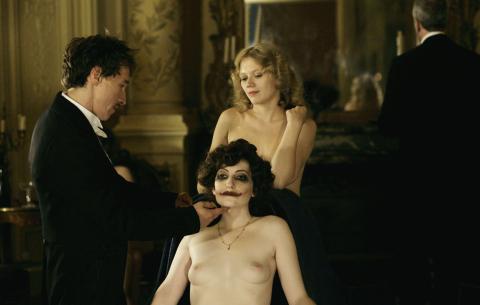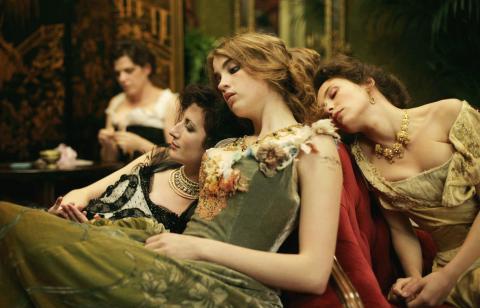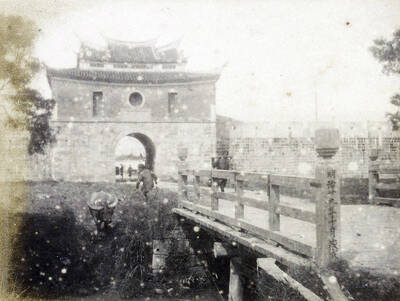Madeline (Alice Barnole), the tragic figure at the heart of Bertrand Bonello’s somber, hypnotic film House of Pleasures (released in the US as House of Tolerance), is a prostitute known as “the woman who laughs” at L’Apollonide, an elegant Parisian brothel at the end of the 19th century. Early in the movie, when she entertains a handsome young client who produces an emerald, she wonders out loud if the gift is a proposal.
But this tender moment is only a dream. The young man, who confesses that he wants to hurt her, has other things in mind. In a subsequent encounter, he coaxes her into letting him tie her up. He produces a knife, trails it lightly across her naked body and between her lips, then slashes her from both corners of her mouth, while she emits a rending scream. For the rest of the film, Madeline’s carved smile is identical to the Joker’s grin in the Batman movies.
Demoted from courtesan to housekeeper, Madeline continues to hover on the edges of the film, a stoic, nearly silent presence. In a later scene she is the impassive erotic object of curiosity at an elaborate sadomasochistic banquet at which the madam has rented her out for the evening.

Photo Courtesy of Flash Forward Entertainment
House of Pleasures, which was shown at the Cannes Film Festival under the name L’Apollonide, is the fifth feature directed by Bonello, a French filmmaker who likes to work on the edge of pornography. Throughout the film there is an abundance of sumptuously photographed flesh on view. But House of Pleasures is not an erotic stimulant so much as a slow-moving, increasingly tragic and claustrophobic operatic pageant set almost entirely in the brothel. The heavy candlelit chiaroscuro paints the women as mobile Renoirs, Degases and Manets. The soundtrack, punctuated with raw soul songs, also uses Nights in White Satin by the Moody Blues and excerpts from La Boheme for maximum contrast and dramatic effect.
As this languidly paced film draws you ever deeper into a cloistered world, which it examines in microscopic detail, you become familiar with its rituals and breathe in an atmosphere that in the words of one character “stinks of sperm and Champagne.” And perfume and scented soap, I would add.
The movie details the rules of the house and shows the women bathing, dressing and preparing for work. Except for a daytime excursion and a brief epilogue set in contemporary Paris, it unfolds entirely inside the mansion. In one uncomfortable scene the women are lined up for minute internal examinations by an imperious male doctor, who pokes at them as if they were slabs of meat. In the days before penicillin, venereal disease was a major occupational hazard. One of the women is found to have syphilis. We are told the conventional scientific wisdom of the day that prostitutes and criminals have smaller heads than other people.

Photo Courtesy of Flash Forward Entertainment
The patrons — most of them are wealthy, older repeat customers — treat the women with a guarded, paternalistic affection that half conceals a profound condescension, one manifestation of which is the pressure on the women to act out elaborate, humiliating fantasies. One is given a chilly Champagne bath. Another goes through the jerky body language of an expressionless marionette. A third is made up as a Japanese geisha and required to speak in a kind of Asian baby talk.
As we become familiar with individual prostitutes, it becomes ever clearer that sex work at L’Apollonide is not a recommended means for a rebellious girl to assert her independence. The youngest, 16-year-old Pauline (Iliana Zabeth), loses her enthusiasm as she realizes there is no future in the work. The best possible outcome is the unlikely prospect of being bought by a wealthy man, which the screenplay suggests is akin to exchanging one prison for another.
All of the women sustain debts incurred by the expense of their high-maintenance appearance. Even the madam, Marie-France (Noemi Lvovsky), whose two children and pet panther live on the premises, is a victim. When the landlord decides to raise her rent astronomically, an official she counted on for help refuses to intervene.
There is only one word to describe life inside L’Apollonide: slavery.

June 9 to June 15 A photo of two men riding trendy high-wheel Penny-Farthing bicycles past a Qing Dynasty gate aptly captures the essence of Taipei in 1897 — a newly colonized city on the cusp of great change. The Japanese began making significant modifications to the cityscape in 1899, tearing down Qing-era structures, widening boulevards and installing Western-style infrastructure and buildings. The photographer, Minosuke Imamura, only spent a year in Taiwan as a cartographer for the governor-general’s office, but he left behind a treasure trove of 130 images showing life at the onset of Japanese rule, spanning July 1897 to

In an interview posted online by United Daily News (UDN) on May 26, current Chinese Nationalist Party (KMT) Chairman Eric Chu (朱立倫) was asked about Taichung Mayor Lu Shiow-yen (盧秀燕) replacing him as party chair. Though not yet officially running, by the customs of Taiwan politics, Lu has been signalling she is both running for party chair and to be the party’s 2028 presidential candidate. She told an international media outlet that she was considering a run. She also gave a speech in Keelung on national priorities and foreign affairs. For details, see the May 23 edition of this column,

The Taiwan People’s Party (TPP) on May 18 held a rally in Taichung to mark the anniversary of President William Lai’s (賴清德) inauguration on May 20. The title of the rally could be loosely translated to “May 18 recall fraudulent goods” (518退貨ㄌㄨㄚˋ!). Unlike in English, where the terms are the same, “recall” (退貨) in this context refers to product recalls due to damaged, defective or fraudulent merchandise, not the political recalls (罷免) currently dominating the headlines. I attended the rally to determine if the impression was correct that the TPP under party Chairman Huang Kuo-Chang (黃國昌) had little of a

At Computex 2025, Nvidia CEO Jensen Huang (黃仁勳) urged the government to subsidize AI. “All schools in Taiwan must integrate AI into their curricula,” he declared. A few months earlier, he said, “If I were a student today, I’d immediately start using tools like ChatGPT, Gemini Pro and Grok to learn, write and accelerate my thinking.” Huang sees the AI-bullet train leaving the station. And as one of its drivers, he’s worried about youth not getting on board — bad for their careers, and bad for his workforce. As a semiconductor supply-chain powerhouse and AI hub wannabe, Taiwan is seeing